Persecutions: Martyrs
WEEK 2: MARTYRS
Persecution:
- Jewish authorities were the first persecutors of the early Church. The Sanhedrin saw the new sect as upsetting the old traditions and customs. They persecuted the Christians not because they were Christians, but because they were “bad Jews”. Stephen was martyred during this time. Christians fled from Judea, traveling all over the world (and spreading Christianity). The persecution in Judea ended suddenly and permanently with the destruction of Jerusalem at the hands of the Romans. The Jewish people had always resented the Roman taxes and rulers. More and more Jews joined the Zealot cause, attacking the Romans in guerilla warfare. In the year 66, the Roman governor, in exasperation, stole the sacred vessels from the temple. The people of Judea rose in rebellion and the Romans were driven out of Judea. But, soon-to-be Emperor Vespasian sent his son, Titus, against Judea with Roman troops. They took all of Judea and laid siege to Jerusalem. In the year 70, Titus burned Jerusalem and destroyed the temple.
- The Romans now get into the act: At first the government did not think the new teaching, an obscure, foreign religion, posed much threat to the Empire. Usually the Romans were very tolerant of the beliefs of the lands they conquered and allowed people to worship their own gods in their own way. Thus, the Jews were allowed the Temple and its ceremonies under Roman government. But, to prove their allegiance to Rome, any subject in any land must recognize the divinity of the Emperor. Each citizen must burn incense before the statue of Caesar. This was required, not so much because of a strong belief that Caesar was god, but to prove the loyalty of the diverse people of the Empire. The Roman government looked upon it sort of like saying the Pledge of Allegiance before the flag of the US. But the Christians viewed it completely differently. They would not burn incense before any other god! The Romans tried to force them, but to no avail. They tried to bribe them, to ridicule them, but to no avail.
Despite the persecution, the early church grew rapidly. Many reasons can be given for this rapid growth. Of course, first is the Lord Himself, the Holy Spirit. But the Spirit works through men and several factors came into play:
- The remarkable organization of the early Church: Jesus Himself trained a set of disciples, 11 besides Judas, plus the 70, to carry on His work. These ordained bishops, priests, and deacons to maintain order but each individual Christian is a part of the “body of Christ”, empowered to use his talents for the Lord.
- The unity of the faith: Christians certainly argued and had different opinions on many topics as witnessed in the letters of St. Paul. But all were united in a single body.
- The fruit of the spirit: Our Lord tells us that a tree is judged by its fruit. Christians were different from other Romans and drew followers like a light in the darkness. Can we say the same today?
Martyrs:
The following is a series of short biographies of a number of well-known martyrs. There were thousands of martyrs in the early Church – too many to include all their stories here. Copy the bios most important to your parish or your students, cut them apart, and give each student a few minutes to prepare a brief presentation on “his” saint.
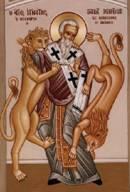 1. St. Ignatius of Antioch: Ignatius had known the apostles when he was a young man. He grew to become a priest and then Bishop of Antioch. As bishop he ordained more men as priests and deacons. The church in Antioch was growing and strong. Ignatius preached wisely to his people and was known as a just and fair man. Unfortunately, he was known also to the pagans, who thought that if they got rid of Ignatius the Church would crumble.
1. St. Ignatius of Antioch: Ignatius had known the apostles when he was a young man. He grew to become a priest and then Bishop of Antioch. As bishop he ordained more men as priests and deacons. The church in Antioch was growing and strong. Ignatius preached wisely to his people and was known as a just and fair man. Unfortunately, he was known also to the pagans, who thought that if they got rid of Ignatius the Church would crumble.
Ignatius was arrested and found guilty of being a Christian. The judge sentenced him to die in Rome. All along the way, guarded by two soldiers, the bishop was greeted by other Christians. He even met St. Polycarp while passing through Smyrna. (Travel with Ignatius from Antioch to Smyrna to Troas, and then to Rome on your map.) All along the way, Ignatius wrote letters to the churches in various cities, telling them to be strong in the Lord. He was not afraid to die; he would be with Jesus. Finally, the good bishop reached Rome. There he was thrown to the lions in the arena – a martyr. He is remembered by the Church on February 1 each year.
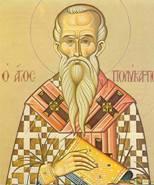
- St. Polycarp of Smyrna: Polycarp’s parents were martyred when he was a little boy.
He was left an orphan on the streets of Smyrna to find food for himself and a place to sleep at night. But, he had been taught to love Jesus by his parents and know that God would care for him.
There was a widow in Smyrna named Callista. She was very rich but had no children. She lived in a big house with many servants. One night in a dream, an angel said to Callista, “Callista, there is an orphan whose name is Polycarp. Take him as your son, for you have no children.” Callista got up right away and brought Polycarp into her home. She loved him as her own son and he had a home and plenty of food.
One day, Callista went on a journey. She left her servants to watch over Polycarp. Now, Polycarp, like the Lord Jesus Himself, loved the poor people who, like he had been, had no food and were starving. So, while Callista was away, Polycarp opened all the cupboards and gave away all the food in the house; there was a lot of food since Callista was very rich. The poor people were so happy! But the servants were shocked and frightened. How would they explain the empty cupboards to their mistress?
One of the servants met Callista on the road outside town as she returned home. He told her how Polycarp had given everything away. Callista was very angry with Polycarp. But, when she got home and looked in the cupboards, they were full! She thought the servant had lied and was about to beat him when Polycarp came running up. He explained that, after he had given away the food, he prayed to God and the cupboards were filled with everything good, even more than before! Callista was amazed. She gave Polycarp all her wealth. Polycarp knew what God wanted him to do. He fasted and prayed thru life, giving all to the poor and helping the sick.
Soon the bishop of Smyrna heard of young Polycarp. He grew to love the young man who so loved the poor. Bishop Vukola ordained Polycarp as a deacon. All the people loved Polycarp for his good works! Later Polycarp became bishop of Smyrna. Finally, when Polycarp was 86 years, an old man indeed, the soldiers came and took him prisoner. The judge begged him to say he would worship the emperor of Rome, but Polycarp would worship only Jesus. They tied him to a pole and lit a fire around Polycarp, but, like the three young men in Babylon, Polycarp was not hurt. Finally, one of the soldiers killed Polycarp with a spear in the heart and this gentle and loving saint died as a martyr during the great persecutions of the Romans against the Church.
- St. Barbara: King Dioscuros loved his daughter Barbara; she was his only child and his special joy. He wanted to keep her safe forever and built in the courtyard of his palace a tall tower. At the very top of the tower lived Barbara. There she was safe from sickness, dangers, and enemies. King Dioscuros worshipped the pagan gods of Rome and hated the new beliefs about a man named Jesus that were sweeping across the land. He was certain that, at the top of a tower, Barbara would never hear of Jesus. Her loving father kept Barbara almost a prisoner; she could only see the countryside from the windows of her tower. She had teachers who told her of the world outside. She would look out her window and see the beauty of the world – the sky and the stars and the sun and the birds. Surely a God created this beautiful world.
To keep her from getting too lonely, King Dioscuros would allow young girls from noble families to visit Barbara in her tow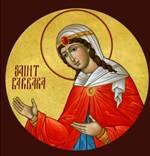 er. Barbara, with her curious and lively mind, asked her friends about the world. From them she heard of Jesus Christ. He was the Son of God, the Creator of the beautiful world Barbara saw from her windows. Barbara decided secretly to become a Christian, too. Her father had built her a bathhouse with a beautiful pool. While her father was away, Barbara decided to make a third window for her pool for the Holy Trinity and had a cross cut in stone above the pool. Then she was baptized in her pool.
er. Barbara, with her curious and lively mind, asked her friends about the world. From them she heard of Jesus Christ. He was the Son of God, the Creator of the beautiful world Barbara saw from her windows. Barbara decided secretly to become a Christian, too. Her father had built her a bathhouse with a beautiful pool. While her father was away, Barbara decided to make a third window for her pool for the Holy Trinity and had a cross cut in stone above the pool. Then she was baptized in her pool.
When her father returned, he saw the changes in the bathhouse. Barbara excitedly told him she had made the changes and had been baptized. King Dioscuros was furious! He drew his sword to kill his daughter! Barbara ran down the stairs of the tower and escaped to the mountaintop nearby. There she prayed to God for help.
The next day the soldiers of the king found Barbara. King Dioscuros locked her in a tiny room and came to her every day asking her to give up her belief in Jesus. But, Barbara would not deny Jesus. Finally, her father sent her to the palace of the governor. There she was given a simple choice: worship the gods of Rome or be killed. Barbara told the governor that she would rather die. She was beaten by the soldiers and thrown into jail with another Christian woman named Julia. There a bright light appeared to Barbara and told her not to be afraid; when she woke up, all of her bruises were gone. The governor beat Barbara again, and again she was healed. Finally, he ordered King Dioscuros to kill his own daughter. Dioscuros hated Christians so much, that he was willing to do even this and beheaded Barbara and Julia on the very mountaintop where she had been captured.
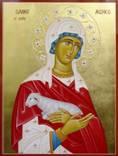 St. Agnes: Many Christians suffered and died during the persecution under the Emperor Diocletian around the year 300. One of these was Agnes. She was only 12 years old at the time. Her parents feared for her safety and tried to keep her at home. They tried to explain that one does not have to seek out martyrdom. But Agnes was not afraid. One day, she left the house and went to look for Roman soldiers. She told them about her faith in Jesus. They immediately arrested her and took her before the magistrate. He thought it would be easy to convince such a young girl to offer sacrifice to the gods. But Agnes had no fear of any of the punishments he threatened. She was imprisoned and tortured, protected by an angel of the Lord. While the soldiers and judges felt sorry for the child, the law demanded her death. She is often represented as a lamb, since the name “Agnes” and the word for lamb, “agnus”, are very similar in Latin.
St. Agnes: Many Christians suffered and died during the persecution under the Emperor Diocletian around the year 300. One of these was Agnes. She was only 12 years old at the time. Her parents feared for her safety and tried to keep her at home. They tried to explain that one does not have to seek out martyrdom. But Agnes was not afraid. One day, she left the house and went to look for Roman soldiers. She told them about her faith in Jesus. They immediately arrested her and took her before the magistrate. He thought it would be easy to convince such a young girl to offer sacrifice to the gods. But Agnes had no fear of any of the punishments he threatened. She was imprisoned and tortured, protected by an angel of the Lord. While the soldiers and judges felt sorry for the child, the law demanded her death. She is often represented as a lamb, since the name “Agnes” and the word for lamb, “agnus”, are very similar in Latin.
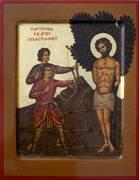 St. Sebastian: Sebastian was born in Gaul (now known as France) and educated in Milan, Italy. He became a soldier in the Roman army, and rose to be a commander. He was also a Christian. When the persecution under the Emperor Diocletian began around the year 300, Sebastian was dismissed from the army. He traveled to Rome and joined the Christian Church there. As time went on, many of his friends were arrested and killed. Sebastian was saddened but encouraged the other Christians to remain strong in their faith.
St. Sebastian: Sebastian was born in Gaul (now known as France) and educated in Milan, Italy. He became a soldier in the Roman army, and rose to be a commander. He was also a Christian. When the persecution under the Emperor Diocletian began around the year 300, Sebastian was dismissed from the army. He traveled to Rome and joined the Christian Church there. As time went on, many of his friends were arrested and killed. Sebastian was saddened but encouraged the other Christians to remain strong in their faith.
Once, Sebastian was arrested. He was tied to a pillar the soldiers shot arrows at him and left him for dead. But the mother of one of his friends saw that he was still breathing and took him home and cared for him until he recovered. Later Sebastian met the emperor. He criticized the emperor for his persecution of Christians. The emperor was so angry that he had Sebastian beaten to death and his body thrown into the sewer. The Christians found his body and buried it in the catacombs. There his grave can be seen today. He is always pictured with arrows.
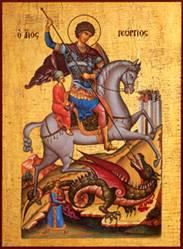 St. George: St. George is always pictured on a horse, with a spear ready to plunge into a dragon. What is his story? Once, long ago, a dragon prowled around the walls of a city. No one could kill the dragon. Finally, the people of the city would put a sheep out each day to keep the dragon from eating all the people. Soon, there were no sheep left. The people had to start feeding their children to the dragon. When his turn came, even the king had to send his daughter out to meet the dragon. But, as the princess walked out the city gates, she met a soldier. He told her he would kill the dragon in the name of Christ. George mounted his horse, made the sign of the cross, and drove his spear into the dragon’s side. He then told the princess to tie her belt around the dragon’s neck. She led the dragon back to the city like a dog on a leash! The people were terrified. George told them that he would kill the dragon if they were all baptized. Soon the king and his people were baptized, and George killed the dragon with his sword. The people rejoiced and built a church in honor of St. George.
St. George: St. George is always pictured on a horse, with a spear ready to plunge into a dragon. What is his story? Once, long ago, a dragon prowled around the walls of a city. No one could kill the dragon. Finally, the people of the city would put a sheep out each day to keep the dragon from eating all the people. Soon, there were no sheep left. The people had to start feeding their children to the dragon. When his turn came, even the king had to send his daughter out to meet the dragon. But, as the princess walked out the city gates, she met a soldier. He told her he would kill the dragon in the name of Christ. George mounted his horse, made the sign of the cross, and drove his spear into the dragon’s side. He then told the princess to tie her belt around the dragon’s neck. She led the dragon back to the city like a dog on a leash! The people were terrified. George told them that he would kill the dragon if they were all baptized. Soon the king and his people were baptized, and George killed the dragon with his sword. The people rejoiced and built a church in honor of St. George.
But, later, when the Emperor Diocletian came to power, Christians were being arrested. St. George was arrested and tortured; the Lord appeared and healed his wounds. Prefect Dacian offered great riches to George if he would only sacrifice to the Roman gods. But, as George knelt down, he prayed and God destroyed the temple and all its idols were swallowed up in the earth! He told the prefect that, if the gods of Rome cannot even save themselves, how can they save others? Dacian was so angry he had George dragged all through the city and finally beheaded – one of the most famous martyrs of the Church.
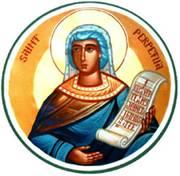 St. Perpetua: Perpetua was a young noblewoman born in Carthage, in northern Africa. She lived near the year 200, during the reign of Septimus Severus. This emperor had initially been tolerant of the Christian Church, but later feared its growth and strength. He arrested many Christians in the large Christian community of Carthage. Most of her family were Christians, but her father was a pagan. Her father loved Perpetua very much. After she was arrested by the Romans, he visited her in prison, hoping to make her deny Christ.
St. Perpetua: Perpetua was a young noblewoman born in Carthage, in northern Africa. She lived near the year 200, during the reign of Septimus Severus. This emperor had initially been tolerant of the Christian Church, but later feared its growth and strength. He arrested many Christians in the large Christian community of Carthage. Most of her family were Christians, but her father was a pagan. Her father loved Perpetua very much. After she was arrested by the Romans, he visited her in prison, hoping to make her deny Christ.
We know about Perpetua’s thoughts because she left a diary. Perpetua worried about her baby, but 2 deacons brought the baby even to the prison for her to nurse. Then she saw a dream. It was a golden ladder leading to heaven. Sharp knives and spears were stuck along the ladder; it could not be climbed without suffering. A dragon lay at the foot of the ladder; its name was “fear”. Her brother, also a Christian, was climbing the ladder and invited her to join him. There was a great light at the top of the ladder.
Even on the day of her trial, Perpetua’s father argued that he would need her to care for him in his old age. The old father wept and pleaded but Perpetua could not renounce God. Even when he brought her baby boy, she would not sacrifice to the Roman gods. Her father cried and clung to her until the prosecutor struck him and knocked him away. St. Perpetua was sadder about her father’s grief than about her own upcoming death; she knew that she would soon be with Jesus. She was taken to the arena to be killed by animals and died with great joy.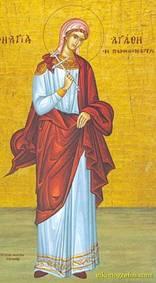
- St. Agatha: Agatha was born in Catana, Sicily, of noble parents. It was said that she was the most beautiful girl alive. But she was also a Christian and loved Jesus with her whole heart. She promised God as a young girl that she would never marry. She would serve Him only.
A wealthy Roman named Quintan wanted to marry Agatha. She refused him over and over. He was so angry, he told the authorities that Agatha was a Christian. She was arrested by the soldiers. The governor told her she would go to prison if she did not give up her faith. But, Agatha was unafraid of prison.
In prison, Agatha was put in the charge of a wicked woman. She tried to tempt Agatha to give up her faith, but Agatha told her about the Lord and the woman became a Christian, too! Agatha was tortured over and over and still would not sacrifice to the Roman gods. Finally, Agatha died from all her wounds. Her veil is kept to this day. In fact, when Mt. Aetna erupted, the Church held St. Agatha’s veil before the flowing lava and the flow ceased right there.
- St. Irene: Irene was the only daughter of the Emperor Licinius. Her parents named her Penelope for her great beauty. When Penelope was 6 years old, her father built her a tower. Everything inside was made of gold and jewels. He locked his daughter in the tower with 13 girls to serve her and an old professor named Appelian to teach her. But, unknown to the emperor, Appelian was a Christian and taught Penelope about the love of God. Penelope was baptized with the name Irene.
One day, while sitting at the table, a pigeon flew thru the window with an olive twig, then an eagle with a crown of flowers, and finally a crow with a small snake. Irene was frightened! She called Appelian and asked him what the odd gifts meant. He told her that the dove was for her love for God, the olive twig for the grace of the Holy Spirit, the eagle and the crown for victory, and the crow and the snake for the martyrdom that would soon be hers.
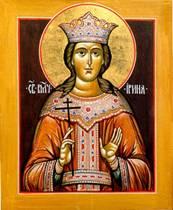 A few days later, Licinius came home and found Irene had smashed all the idols in the house. He was so angry, he ordered his servants to tie Irene to the ground and trample her with the horses. But the horses protected Irene and one killed the emperor! Irene prayed and her father was raised from the dead. He became a Christian and was baptized with his wife and 3000 men. He renounced his throne and spent the rest of his life in the tower he built for his daughter.
A few days later, Licinius came home and found Irene had smashed all the idols in the house. He was so angry, he ordered his servants to tie Irene to the ground and trample her with the horses. But the horses protected Irene and one killed the emperor! Irene prayed and her father was raised from the dead. He became a Christian and was baptized with his wife and 3000 men. He renounced his throne and spent the rest of his life in the tower he built for his daughter.
But, new emperors came to power. Irene traveled from city to city, preaching Christ to anyone who would listen. She was arrested and tortured and finally beheaded for her faith.
- St. Cecilia: Cecelia was a rich and noble girl of Rome. Her family were Christian and she grew to love the Lord with her whole heart. She wore a rough dress under her fashionable clothes and often fasted from food. Cecilia decided that she would give her life to God and not marry any man.
But, Cecilia’s father arranged her wedding anyway, to a young man named Valerian. Valerian was not a Christian. During the marriage feast, Cecilia sat away from the guests, singing songs of praise to God. She is usually pictured with a harp. When Cecilia and Valerian finally left the wedding feast, she told her new husband that she was truly the bride of Christ and that an angel would protect her if he tried to force her to his bed. Valerian was angry and asked her to show him this angel. Cecilia told him that if he were baptized, he would see the angel. Valerian was baptized by Bishop Urban. When he returned to their room, Valerian saw his bride Cecilia and, standing next to her, an angel. The angel put a crown of roses and lilies on the head of each.
Tiburtius, Valerian’s brother, also became a Christian after talking to Cecilia. The three young Christians devoted themselves to good works. Because they buried the bodies of Christians who had died for the Lord, the two brothers were also arre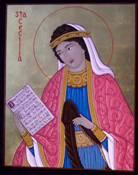 sted and killed. Cecilia buried their bodies, and she was also arrested. But the soldiers who came to arrest her instead became Christians! 400 people were baptized in her house – a church is dedicated there in her name.
sted and killed. Cecilia buried their bodies, and she was also arrested. But the soldiers who came to arrest her instead became Christians! 400 people were baptized in her house – a church is dedicated there in her name.
More soldiers came and took Cecilia to court. She would not worship the pagan gods. They tried to kill her, but for three days she lingered alive. During that time, she arranged for her house to be given to the Church. She is buried in the catacombs, the deep caves and tunnels under the city of Rome.
Quiz Questions:
Fill in the blanks (or print the answer in large letters, cut the letters apart, and have the students unscramble them to find the name):
- The martyr who fed the poor with the miraculous food was ________________.
- The martyr who was the Bishop of Antioch was _____________________.
- The martyr who was shot full of arrows was _____________________.
- The martyr whose name is like “lamb” was _____________________.
- The martyr who killed the dragon was ______________________.
- The martyr who sang psalms at her own wedding feast was __________________.
- The martyr who saw a dove, an eagle, and a crow was ____________________.
- The martyr whose veil stopped the lava of Mt. Aetna was ____________________.
- The martyr who was baptized in her tower pool was ____________________.
- The martyr who nursed her baby in prison was _____________________.
- The first martyr was _________________________.
- The apostle who was martyred in Rome on an upside down cross was ___________.
Primstav: Add these wonderful martyrs on their feast days. Use the stories of their martyrdom to develop a symbol for each:
St. Ignatius December 20
St. Barbara December 4
St. Polycarp February 23
St. Agnes January 21
St. Sebastian December 18
St. George April 23
St. Perpetua February 1
St. Agatha February 5
St. Irene May 5
St. Cecilia November 22
Close with Prayer.